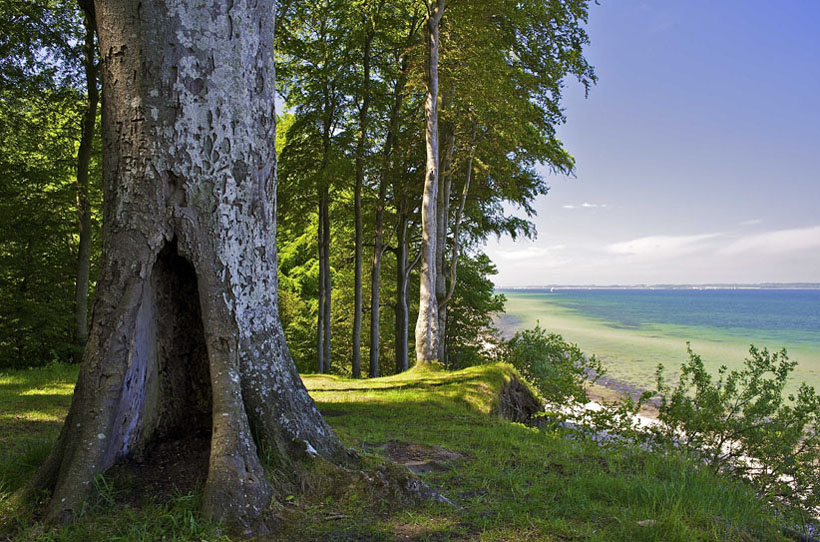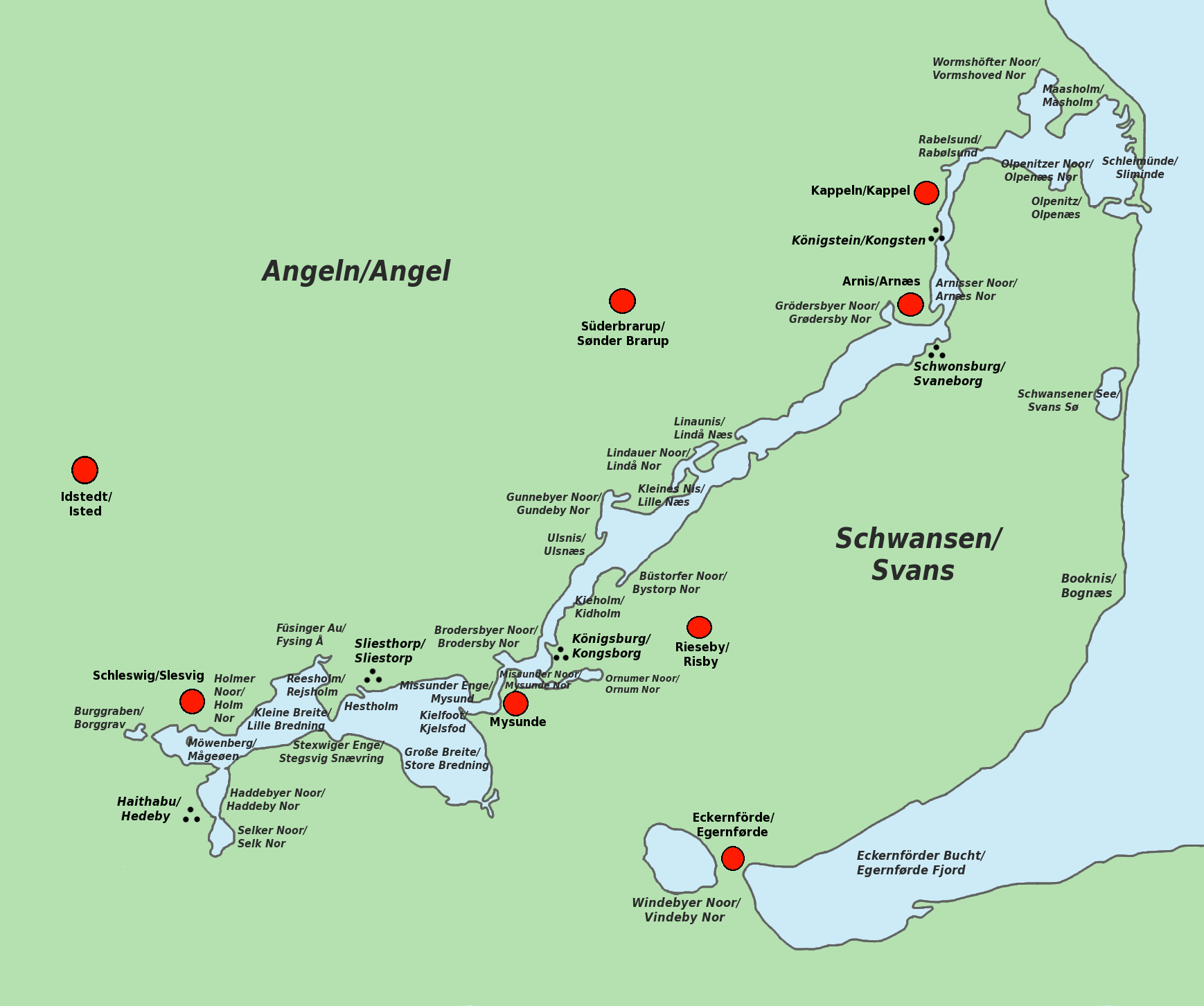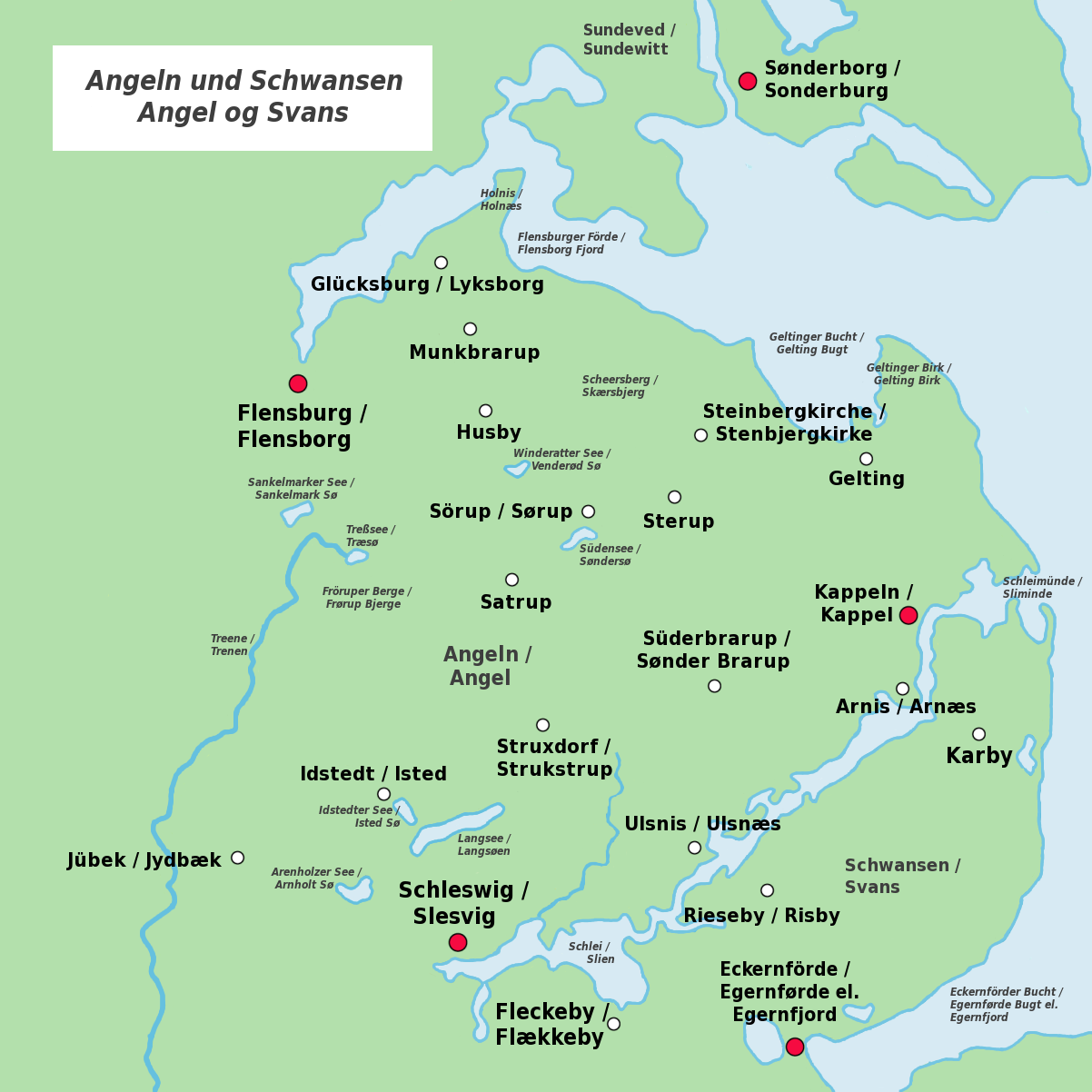|
Schwansen
Schwansen ( or ''Svansø'', meaning "swan island/peninsula") is a peninsula in Schleswig-Holstein, Germany, protruding into the Baltic Sea. It is located between Eckernförde Bay to the south and the Schlei inlet to the north. The Danish dialect South Jutlandic in the Angel Danish variant was still spoken in Schwansen around 1780 (the last time in the villages near the Schlei). Denmark lost Schwansen following the Second Schleswig War The Second Schleswig War (; or German Danish War), also sometimes known as the Dano-Prussian War or Prusso-Danish War, was the second military conflict over the Schleswig–Holstein question of the nineteenth century. The war began on 1 Februar ... in 1864. Schwansen is the name of the former '' Amt'' ("collective municipality") Schwansen, which covered most of the peninsula. The seat of the ''Amt'' was in Damp. Peninsulas of Schleswig-Holstein Regions of Schleswig-Holstein Peninsulas of the Baltic Sea {{SchleswigHolstein-ge ... [...More Info...] [...Related Items...] OR: [Wikipedia] [Google] [Baidu] |
Schleswig-Holstein
Schleswig-Holstein (; ; ; ; ; occasionally in English ''Sleswick-Holsatia'') is the Northern Germany, northernmost of the 16 states of Germany, comprising most of the historical Duchy of Holstein and the southern part of the former Duchy of Schleswig. Its capital city is Kiel; other notable cities are Lübeck and Flensburg. It covers an area of , making it the 5th smallest German federal state by area (including the city-states). Historically, the name can also refer to a larger region, containing both present-day Schleswig-Holstein and the former South Jutland County (Northern Schleswig; now part of the Region of Southern Denmark) in Denmark. Schleswig, named South Jutland at the time, was under Danish control during the Viking Age, but in the 12th century it became a duchy within Denmark due to infighting in the Danish Royal House. It bordered Holstein, which was a part of the Holy Roman Empire. Beginning in 1460, the King of Denmark ruled both Schleswig and Holstein as the ... [...More Info...] [...Related Items...] OR: [Wikipedia] [Google] [Baidu] |
Germany
Germany, officially the Federal Republic of Germany, is a country in Central Europe. It lies between the Baltic Sea and the North Sea to the north and the Alps to the south. Its sixteen States of Germany, constituent states have a total population of over 84 million in an area of , making it the most populous member state of the European Union. It borders Denmark to the north, Poland and the Czech Republic to the east, Austria and Switzerland to the south, and France, Luxembourg, Belgium, and the Netherlands to the west. The Capital of Germany, nation's capital and List of cities in Germany by population, most populous city is Berlin and its main financial centre is Frankfurt; the largest urban area is the Ruhr. Settlement in the territory of modern Germany began in the Lower Paleolithic, with various tribes inhabiting it from the Neolithic onward, chiefly the Celts. Various Germanic peoples, Germanic tribes have inhabited the northern parts of modern Germany since classical ... [...More Info...] [...Related Items...] OR: [Wikipedia] [Google] [Baidu] |
Baltic Sea
The Baltic Sea is an arm of the Atlantic Ocean that is enclosed by the countries of Denmark, Estonia, Finland, Germany, Latvia, Lithuania, Poland, Russia, Sweden, and the North European Plain, North and Central European Plain regions. It is the world's largest brackish water basin. The sea stretches from 53°N to 66°N latitude and from 10°E to 30°E longitude. It is a Continental shelf#Shelf seas, shelf sea and marginal sea of the Atlantic with limited water exchange between the two, making it an inland sea. The Baltic Sea drains through the Danish straits into the Kattegat by way of the Øresund, Great Belt and Little Belt. It includes the Gulf of Bothnia (divided into the Bothnian Bay and the Bothnian Sea), the Gulf of Finland, the Gulf of Riga and the Bay of Gdańsk. The "Baltic Proper" is bordered on its northern edge, at latitude 60°N, by Åland and the Gulf of Bothnia, on its northeastern edge by the Gulf of Finland, on its eastern edge by the Gulf of Riga, and in the ... [...More Info...] [...Related Items...] OR: [Wikipedia] [Google] [Baidu] |
Eckernförde Bay
Eckernförde Bay (; ) is a firth and a branch of the Bay of Kiel between the Danish Wahld peninsula in the south and the Schwansen peninsula in the north in the Baltic Sea off the lands of Schleswig-Holstein, Germany. The bay extends around deep into the land and is wide at its entrance where ''Booknis-Eck'' (municipality of ''Waabs'') and ''Danish-Nienhof'' (municipality of ''Schwedeneck'') mark the endpoints. The bay is up to deep. The border to the Kiel Fjord lies at the Bülk Lighthouse. The once forested Danish Wahld peninsula between Kiel Fjord and Eckernförde Bay constituted the borderland between the Saxons and the Danes (Germanic tribe), Danes until the Middle Ages. At the inner end of the bay lies the town of Eckernförde. Geography The bay formed during the Last Glacial Period, last Ice Age between 120,000 and 10,000 years ago from a glacier. According to some geologists, the Bathymetry, depth contour of the Eckernförde Bay had already formed before the Ice Age a ... [...More Info...] [...Related Items...] OR: [Wikipedia] [Google] [Baidu] |
Schlei
The Schlei (; or e.g. in: Adolph Frederik Bergsøe: ''Den danske stats statistik'', Kjøbenhavn 1844, p. 156) is a narrow inlet of the Baltic Sea in Schleswig-Holstein in northern Germany. It stretches for approximately 20 miles (32 kilometers) from the Baltic near Kappeln and Arnis to the town of Schleswig. Along the Schlei are many small bays and swamps. It separates the Angeln peninsula to the north from the Schwansen peninsula to the south. The important Viking settlement of Hedeby was located at the head of the firth (fjord), but was later abandoned in favor of the town of Schleswig. A museum has been built on the site, telling the story of the abandoned town. Etymology The Schlei's name was once presumably ''Angel'',Wolfgang Laur: ''Historisches Ortsnamenlexikon von Schleswig-Holstein'', 2nd edition, Neumünster 1992. later giving its name to the region Angeln Angeln (; ) is a peninsula on the Baltic Sea, Baltic coast of Jutland, in the Bay of Kiel. It forms p ... [...More Info...] [...Related Items...] OR: [Wikipedia] [Google] [Baidu] |
South Jutlandic
South Jutlandic or South Jutish ( South Jutish: ; ; ) is a dialect of the Danish language. South Jutlandic is spoken in Southern Jutland (''Sønderjylland''; also called Schleswig or Slesvig) on both sides of the border between Denmark and Germany. Variants of the dialect include Western and Eastern South Jutlandic (including Alsisk). The former variant in Angeln (Danish: ''Angel'') and Schwansen (''Svansø'') was known as Angel Danish. The other dialects classified as belonging to the Jutlandic or Jutish (''Jysk'') group of dialects are West, East, and North Jutlandic. Usage Northern Slesvig Many older people will still speak a distinct South Jutlandic dialect, both in towns and rural areas. Younger people and children are more likely to use a dialect-tinted version of Standard Danish, but everything ranging from relatively pure dialect to Standard Danish can be found. Many are able to switch between both varieties. A renewed popular interest in preserving the ... [...More Info...] [...Related Items...] OR: [Wikipedia] [Google] [Baidu] |
Angel Danish
Angel Danish (German: ''Angeldänisch'', Danish: ''Angeldansk'' or ''Angelbomål'') was a variant of South Jutlandic spoken in the regions of Angeln and Schwansen in Southern Schleswig partly until the 20th century. Both landscapes belonged to the Danish Duchy of Schleswig until 1864, since then to Germany. Characteristic of Angel Danish was, among other things, the tonal pitch accent (like in the Danish dialects of Als and Langeland as well as in Swedish and Norwegian) and the fricative for the hard ''G'' (like today in the Angel Low German). There were also elevations from /o/ to /u/ (instead of Danish ''honning'' it was ''hunne'' in Angel Danish, cf. Icelandic ''hunang''). There were also older Nordic forms such as ''hvénner'' (German ''wenn'', Danish ''hvornår'', Old Norse ''hvenær''), ''mjølk'' (German ''Milch'', Danish ''mælk'', Old Norse ''mjólk'') or ''gut'' (German ''Junge'', Danish ''dreng'', Norwegian ''gutt''). However, there were also adoptions from Germa ... [...More Info...] [...Related Items...] OR: [Wikipedia] [Google] [Baidu] |
Denmark
Denmark is a Nordic countries, Nordic country in Northern Europe. It is the metropole and most populous constituent of the Kingdom of Denmark,, . also known as the Danish Realm, a constitutionally unitary state that includes the Autonomous administrative division, autonomous territories of the Faroe Islands and Greenland in the north Atlantic Ocean.* * * Metropolitan Denmark, also called "continental Denmark" or "Denmark proper", consists of the northern Jutland peninsula and an archipelago of 406 islands. It is the southernmost of the Scandinavian countries, lying southwest of Sweden, south of Norway, and north of Germany, with which it shares a short border. Denmark proper is situated between the North Sea to the west and the Baltic Sea to the east.The island of Bornholm is offset to the east of the rest of the country, in the Baltic Sea. The Kingdom of Denmark, including the Faroe Islands and Greenland, has roughly List of islands of Denmark, 1,400 islands greater than in ... [...More Info...] [...Related Items...] OR: [Wikipedia] [Google] [Baidu] |
Second Schleswig War
The Second Schleswig War (; or German Danish War), also sometimes known as the Dano-Prussian War or Prusso-Danish War, was the second military conflict over the Schleswig–Holstein question of the nineteenth century. The war began on 1 February 1864, when Prussian and Austrian forces crossed the border into the Danish fief Schleswig. Denmark fought troops of the Kingdom of Prussia and the Austrian Empire representing the German Confederation. Like the First Schleswig War (1848–1852), it was fought for control of the duchies of Schleswig, Holstein and Lauenburg. Succession disputes concerning the duchies arose when the Danish king died without an heir acceptable to the German Confederation. The war started after the passing of the History of Schleswig-Holstein#The November Constitution, November Constitution of 1863, which tied the Duchy of Schleswig more closely to the Denmark, Danish kingdom, which was viewed by the German side as a violation of the London Protocol (1852), L ... [...More Info...] [...Related Items...] OR: [Wikipedia] [Google] [Baidu] |
Amt (subnational Entity)
Amt is a type of administrative division governing a group of municipalities, today only in Germany, but formerly also common in other countries of Northern Europe. Its size and functions differ by country and the term is roughly equivalent to a British or U.S. county. Current usage Germany Prevalence The ''Amt'' (plural: ''Ämter'') is unique to the German ''States of Germany, Bundesländer'' (federal states) of Schleswig-Holstein, Mecklenburg-Western Pomerania and Brandenburg. Other German states had this division in the past. Some states have similar administrative units called ''Samtgemeinde'' (Lower Saxony), ''Verbandsgemeinde'' (Rhineland-Palatinate) or ''Municipal association (Germany), Verwaltungsgemeinschaft'' (Baden-Württemberg, Bavaria, Saxony, Saxony-Anhalt, Thuringia). Definition An ''Amt'', as well as the other above-mentioned units, is subordinate to a ''Kreis'' (district) and is a collection of municipalities. The amt is lower than district-level government ... [...More Info...] [...Related Items...] OR: [Wikipedia] [Google] [Baidu] |







